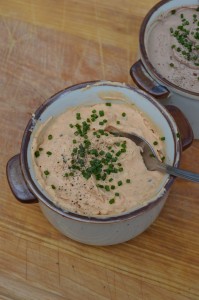 This is a tasty spread I often serve at Austrian cooking classes.
This is a tasty spread I often serve at Austrian cooking classes.
Liptauer is originally from Liptov, in Slovakia, formerly part of the Austro-Hungarian empire. The dish became quite popular in Austria-proper, and is now considered a classic part of that country’s cuisine.
In Austria Liptauer is made with a soft, fresh cheese called Topfen. Topf is the German word for pot, so Topfen can be translated as “pot cheese”. It goes by the name Quark (pronounced “KVARK”) in many other parts of Europe. Austrians will scoff, but the recipe below approximates Topfen by using a mixture of cream cheese and sour cream.
Besides cheese, the other essential ingredient in Liptauer is paprika, which is ubiquitous in several Eastern European cuisines. The paprika that has been on your shelf for two years has no flavour and a russet colour. Fresh paprika from quality-conscious merchants will have a much better flavour and a bright red colour, giving the Liptauer a friendly, salmon colour.
In Austria Liptauer is served with rye bread, as a snack, an appetizer, or Brettljause at a Heuriger (see this post on Heurigen). This is not even remotely traditional, but I also use it as a spread on sandwiches.
Liptauer (an approximation…)
Ingredients
- 510 g cream cheese
- 120 g full fat sour cream
- 50 mL sweet paprika
- 1 tbsp caper, minced
- 1/2 clove garlic, minced
- 3 anchovy fillets, the tinned variety preserved in oil, minced
- 1/2 a small shallot, minced
- 1/2 tbsp smooth Dijon mustard
- 1 tbsp parsley, minced
- 1/2 tbsp cider vinegar
- black pepper to taste
- chive to garnish
Procedure
- Combine the cream cheese and sour cream in the bowl of a stand mixer. Beat with the paddle attachment until very smooth, about 2 minutes on high speed, scraping down the sides of the bowl part way through.
- Add the remaining ingredients and beat until thoroughly combined.
- Taste and adjust seasoning as necessary.
- Serve with rye bread. Liptauer is also good with radishes when they are in season.